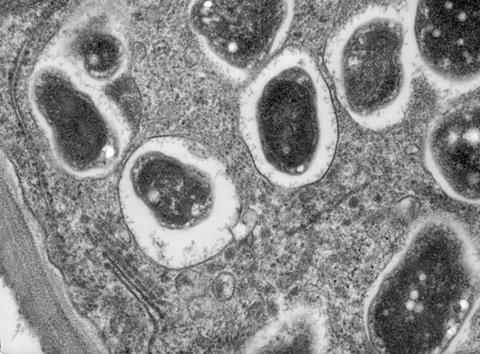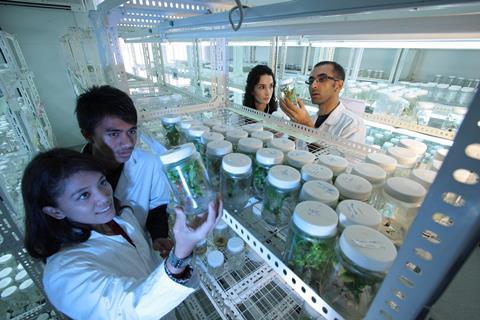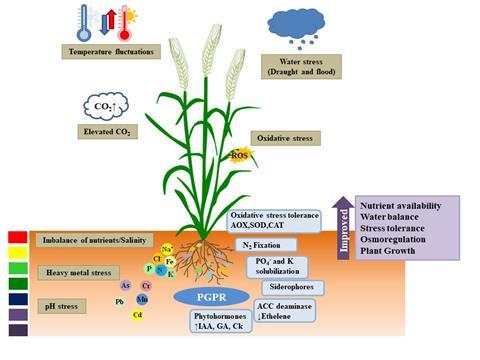In the face of environmental degradation and climate change, farmers are increasingly challenged to sustain productivity and ensure food security. The challenges confronting farmers because of environmental issues are multifaceted and have profound implications for food production. Several factors like salinity, extreme weather, waterlogging, droughts, and pollution contribute to these challenges.
Excessive salinity in the soil disrupts the ability of plants to absorb water and nutrients, leading to poor growth and reduced crop yields. High salt levels inhibit the uptake of water by plant roots, creating an environment where only certain salt-tolerant crops can survive. This limitation significantly impacts the diversity and quantity of crops that farmers can cultivate.
Extreme weather conditions including excessively hot or cold temperatures, pose another significant threat to crop health. Temperature extremes can cause physical damage to plants leading to reduced productivity and sometimes complete crop failure. Prolonged exposure to unsuitable temperatures stresses plants, hindering their growth and development, and resulting in lower agricultural output.
Water management is another critical issue farmers face, as both waterlogging and droughts adversely affect crop health. Waterlogged soil deprives plant roots of necessary oxygen, disrupting their ability to absorb nutrients and leading to root rot or other diseases. Conversely, drought conditions deprive plants of essential moisture, leading to wilting, stunted growth, and in severe cases, plant death.

Pollution from industrial activities introduces harmful contaminants into the soil and water used for agriculture. Pollutants like heavy metals (e.g. lead and cadmium) can accumulate in crops, posing serious health risks to consumers. Contaminated water sources used for irrigation further exacerbate this problem, leading to the accumulation of toxins in the food chain. These pollutants not only diminish the quality of agricultural produce but also pose long-term risks to soil health, making it difficult for future crops to thrive.
Climate Change and Agriculture
Climate change compounds the existing challenges faced by farmers, making it increasingly difficult to sustainably meet the rising global food demand. As the global population continues to grow, so does the demand for food. With nearly 9.7 billion people projected to inhabit the planet by 2070, farmers face immense pressure to produce more food to meet this increasing demand. This puts a significant strain on agricultural systems worldwide. Expanding agricultural land to meet the rising food demand is not a simple task. There’s limited available space for agriculture, with much of the arable land already utilized for farming. The challenge lies in intensifying production on existing agricultural lands without further encroaching on natural ecosystems such as forests and wetlands.
Climate change exacerbates the unpredictability of weather patterns, introducing extreme events like droughts, floods, heatwaves, and storms. These erratic weather patterns disrupt traditional farming practices and make crop cultivation more challenging and unpredictable. Climate change also exacerbates resource scarcity, including water shortages and soil degradation. Changes in precipitation patterns and increased evaporation rates lead to water stress in many agricultural regions, affecting irrigation and crop water requirements. Additionally, soil erosion, nutrient depletion, and loss of soil fertility further degrade agricultural lands, reducing their productivity over time. Moreover, climate change influences the distribution and abundance of pests and diseases, posing additional challenges to crop production.
Warmer temperatures and changing precipitation patterns significantly affect agricultural ecosystems by forming favourable environments for the propagation of pests and pathogens, leading to increased pest pressure and disease outbreaks in agricultural crops. Addressing these challenges requires comprehensive strategies, including improved soil management practices, the development of resilient crop varieties, effective irrigation systems, and stringent pollution control measures.

Plant Growth Promoting Rhizobacteria (PGPR)
Microorganisms, often likened to tiny superheroes, play a crucial role in maintaining environmental health and fostering sustainable agriculture. Among these microorganisms are Plant Growth-Promoting Rhizobacteria (PGPR), which are particularly significant in farming.
These beneficial bacteria live in the rhizosphere, the region of soil directly surrounding plant roots, where they form symbiotic relationships with plants. This partnership benefits both the bacteria and the plants, enhancing nutrient uptake, growth, and resilience to environmental stressors. One of the key abilities of PGPR is nitrogen fixation, where they convert atmospheric nitrogen into a plant-usable form. This process provides plants with a vital nutrient for growth, reducing the reliance on synthetic nitrogen fertilizers and mitigating environmental pollution associated with nitrogen runoff.
PGPR also assist plants in acquiring phosphorus from the soil. Phosphorus is essential for energy transfer, photosynthesis, and root development in plants. By solubilizing phosphorus and making it more available to plants, PGPR promote healthy growth and development, particularly in phosphorus-deficient soils. Plus, PGPR make special hormones that tell plants to grow more roots and leaves, making them even stronger. These bacteria even fight off bad germs or pathogens that can make plants sick, keeping them healthy without needing lots of chemicals. Incorporating PGPR into agricultural practices aligns with the principles of sustainable agriculture.

Stress Tolerance
PGPR act as vital allies for plants, especially when they face environmental stresses. These beneficial bacteria enhance plant’s resilience and productivity under harsh conditions through various mechanisms. They have a bunch of tricks up their sleeves. PGPR produce substances that inhibit harmful pathogens, preventing them from thriving near plants. These substances include antibiotics, siderophores, and lytic enzymes, which directly antagonize pathogenic microbes.
Another remarkable function of PGPR is their ability to enhance soil moisture retention. They produce exopolysaccharides, which improve soil structure and water-holding capacity. During dry conditions, PGPR help plants by facilitating the production of osmoprotectants-compounds that enable plants to maintain cellular functions and structure despite water scarcity. These mechanisms collectively help plants withstand and recover from drought stress. When it comes to saline soils, PGPR aid plants in managing osmotic stress by improving nutrient uptake and maintaining ionic balance. They produce phytohormones like auxins, cytokinins, and gibberellins which help plants absorb nutrients more efficiently, even in salty conditions, thereby mitigating the adverse effects of salinity on plant health.
PGPR also act as facilitators of nutrient acquisition. They can fix atmospheric nitrogen, solubilize phosphate, and mobilize other essential minerals, making them more available to plants. By stimulating root growth and development, PGPR increase the root surface area, enhancing the plant’s ability to access and absorb nutrients from the soil. This is particularly beneficial in nutrient-poor soils, where plants struggle to obtain sufficient nourishment.

Challenges from Laboratory to Land
In laboratory settings, PGPR thrive because scientists create ideal conditions for their growth and activity. These controlled environments ensure optimal temperature, moisture, and nutrient availability, eliminating the presence of competing or harmful microbes. However, when PGPR are applied in real agricultural fields, they encounter numerous challenges. Unlike stable and controlled lab environments, fields are subject to fluctuating conditions and a variety of stress factors that can hinder PGPR effectiveness. Some of these factors include:
Environmental Variability: Unlike the consistent temperatures in labs, field temperatures can vary widely between day and night and across seasons, affecting the survival and activity of PGPR. In the field, rainfall patterns can be unpredictable, leading to periods of drought or waterlogging, both of which can negatively impact PGPR function and survival.
Competition with Native Microorganisms: Fields contain diverse microbial communities, including other bacteria, fungi, and protozoa, which compete with PGPR for space and resources. This competition can reduce the effectiveness of PGPR. Soil predators, such as nematodes and protozoa can prey on PGPR, reducing their population and effectiveness.
Soil Characteristics: Field soils differ significantly in pH, texture, and organic matter content, which can influence PGPR colonization and activity. Natural soils may have varying levels of essential nutrients, which can affect the ability of PGPR to solubilize and provide these nutrients to plants.
Inoculant Formulation and Delivery: Ensuring even and effective distribution of PGPR in the soil is challenging, and improper application can lead to suboptimal colonization.
Plant-Microbe Interactions: Different plant species and even varieties within species can interact with PGPR differently, affecting the consistency and reliability of PGPR benefits. The composition of root exudates, which are chemicals secreted by plant roots, varies among plants and can influence PGPR colonization and activity.
Long-Term Persistence and Efficacy: PGPR need to establish themselves in the rhizosphere (root zone) and persist over time to be effective, which can be difficult in dynamic field conditions.

To deal with the challenges PGPR face in real fields, scientists, farmers, and agronomists need to collaborate and develop effective strategies to ensure that PGPR can thrive, adhere to plant roots, and perform their beneficial functions under field conditions. Here are several strategies to enhance PGPR inoculum efficacy in the field:
Possible Solutions
Choosing the Right PGPR: Identify and select PGPR strains that are robust and adaptable to local environmental conditions, including variable soil types, climates, and existing microbial communities. This can involve screening for PGPR that can withstand stress factors such as drought, salinity, and heavy metals. Choose PGPR strains that have shown compatibility and effectiveness with local plant species and varieties to ensure better symbiotic relationships.
Making PGPR Stronger: Develop advanced formulations that enhance the viability and stability of PGPR during storage, transport, and application. This can include encapsulation techniques, protective carriers, and additives that support PGPR survival and function. Use substances like biochar, alginate, or other organic materials that can protect PGPR from environmental stresses and improve their persistence in the soil.
Teamwork with Other Microbes: Utilize consortia of different PGPR strains that have synergistic effects, enhancing each other’s capabilities. This can improve nutrient acquisition, disease suppression, and stress tolerance. Incorporate beneficial fungi, such as mycorrhizae, that work alongside PGPR to enhance plant growth and soil health.
Better Ways to Put PGPR in the Soil: Develop innovative application methods such as seed coatings, root dips, and soil drenches that ensure PGPR are delivered directly to the root zone where they can be established effectively. Use precision agriculture technologies to apply PGPR in a targeted manner, optimizing their placement and efficacy.
Mixing with Other Plant Helpers: Combine PGPR with biostimulants, organic fertilizers, and other plant growth enhancers to amplify their positive effects on plant growth and stress resilience. Integrate PGPR with other IPM strategies to provide a holistic approach to plant health and pest control.
Improving the Soil: Improve soil conditions by adding organic matter, compost, and other amendments that create a favourable environment for PGPR and other beneficial microbes. Implement soil health practices such as reduced tillage, cover cropping, and crop rotation to enhance soil structure, fertility, and microbial diversity.
Changing the Way We Grow: Promote crop diversity and the use of cover crops to improve soil health and provide a continuous habitat for PGPR. Adopt agroecological practices that support ecological balance and sustainable agriculture.
Checking How Well It Works: Conduct extensive field trials to evaluate the performance of PGPR under real-world conditions. Monitor plant growth, yield, soil health, and microbial activity to assess the effectiveness and benefits of PGPR inoculation. Use data analytics and remote sensing technologies to gather and analyze data on PGPR efficacy and environmental impact.
Talking to Everyone: Foster collaboration between farmers, scientists, agronomists, and extension services to share knowledge, experiences, and best practices related to PGPR use. Provide training programs and resources for farmers to understand the benefits of PGPR and how to effectively integrate them into their farming practices. Increase public awareness about the role of PGPR in sustainable agriculture through outreach programs, workshops, and publications.
By integrating these strategies, researchers, agronomists, and farmers can optimize PGPR inoculum efficacy in field conditions, leading to improved crop productivity, soil health, and environmental sustainability. Through collaborative efforts and continued innovation, PGPR can become a reliable tool for enhancing agricultural resilience and sustainability, ensuring food security and ecological balance.















No comments yet